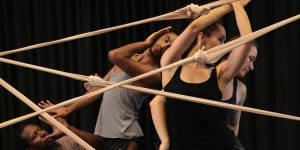IMPRESSIONS: Kitty Lunn and Infinity Dance Theater present "Frida Kahlo and the Dance with Death"

At Theater for the New City
Choreographer: Kitty Lunn
Performers: Kitty Lunn and Luisa Righeto
Narrator: Jim Trainor
Original Score: William Catanzaro
Costume Design: Lydia Gladstone
Lighting Design: Alexander Bartenieff
Artwork: Frida Kahlo and Carol Prud’homme Davis
Date: September 15, 2023
At first glance, one might think Mexican painter Frida Kahlo and Scottish-American dancer Kitty Lunn have little in common. However, as Lunn asserts in her world premiere Frida Kahlo and the Dance with Death, the two women are more alike than meets the eye. Through spoken word, music, and movement, with several of Kahlo’s paintings as a backdrop, Lunn and dancer Luisa Righeto draw parallels between the life experiences of the painter and choreographer and the artistic practices that sustained both women.
Narrations by Jim Trainor serve as transitions between four distinct scenes in the evening, and provide background information on both Kahlo and Lunn. Through him, audiences learn how close the two women came to death, and how many times. Both women suffered life-changing spinal cord injuries as a result of accidents that left them disabled, in constant pain, and unable to bear children. Both endured years of painful treatments with little result. Both attempted suicide. However, rather than submit to darkness, Lunn chose to focus on resiliency and hope.

In 1995, eight years after her slip down a flight of stairs, Lunn founded Infinity Dance Theater, a non-traditional dance company committed to expanding dances boundaries and changing the perception of who a dancer can be. The company features performers with and without disabilities. Lunn’s style, founded in classical ballet and influenced by modern dance, transposes these techniques to suit the abilities of her dancers while utilizing their specific skills and prior training. Lunn herself performs using a specialized wheelchair that allows her to move with speed and precision.
Frida Kahlo and the Dance with Death opens with Righeto, a non-disabled dancer and artistic associate of Infinity Dance Theater, dressed in a skeleton unitard and glowing Day of the Dead mask. With stomping feet and staccato gestures, she establishes herself as the archetype of Death, reminiscent of the figure in Kurt Jooss’ The Green Table. Despite her slight frame, Righeto commands her role with fierce attack and strength. Influences of Graham and Limón techniques are visible in her controlled contractions and the interplay between weight and buoyancy.

In the following scene, Lunn is seated on a bench with her feet in a basin of blood. A paraplegic with minimal use of her lower extremities, she manipulates her legs around the bench, dragging them where she needs them to be. With fluidity and strength, she lowers herself to the floor, rolling across the stage and reaching her upper body skyward.
When she approaches the only set piece — a long white dress hanging from the ceiling — she sits in front of it and paints its bodice with red lipstick. (Kahlo similarly painted her garments — the various plaster corsets which she wore throughout her life for spinal support.) Lunn, then removes a long red cord from her costume, cradling it like a baby. Seated with her back to the audience, she tenderly wraps the cord around herself, her eyes never straying from it as she opens and closes her arms. Toward the end of the scene, she moves behind the dress and pushes herself to standing, her arms triumphantly outstretched, asserting dominance over parts of her body which she seemed at the mercy of only moments before.

Righeto returns for a short solo before Lunn re-enters, now in her wheelchair. They dance, a smooth flowing duet. They push, pull, and envelope one another. They reach, support, and propel each other. The blood-red ribbon from the prior scene connects the couple like an umbilical cord, here it seems to signify both life and death. For Kahlo and for Lunn, the two states always danced together. After Lunn’s tousle and embrace with life and death (Righeto), she deftly maneuvers her chair away from her partner using her arms to suspend and redirect its momentum. An overwhelming sense of freedom pervades, freedom and an unshakable desire for life.
Lunn paints a vivid portrait which reminds us that unwanted agony can be our greatest teacher, and vulnerability, our gift to others. Plunging into her internal world through art, Lunn ultimately has learned to value her life and creative expression. In Frida Kahlo and the Dance with Death, she calls on us to value ours.














